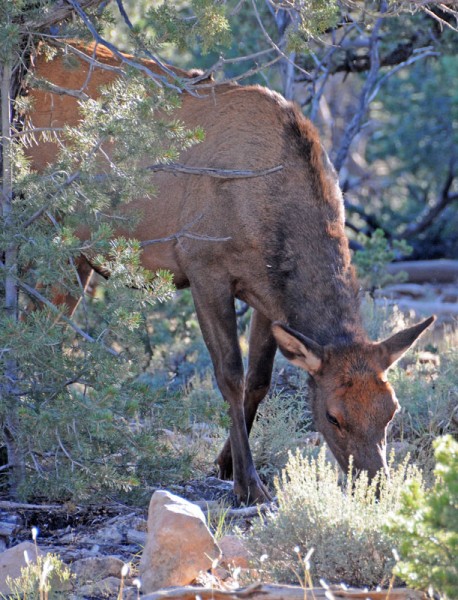Experimental CWD Vaccine Failing Initial Tests
Patrick Durkin 12.14.15

Hopes for a vaccine to prevent chronic wasting disease (CWD) suffered a severe blow when Wyoming researchers announced in early November that elk inoculated with an experimental serum were at least three times more likely to contract CWD than unvaccinated elk.
The researchers are testing a vaccine developed by the Pan-Provincial Vaccine Enterprise Inc., or PREVENT, at the University of Saskatchewan. The study began about three years ago with 38 elk at the Tom Thorne and Beth Williams Wildlife Research Center north of Laramie, Wyoming.
After being placed in a CWD-contaminated outdoor enclosure in February 2013, half of the elk received two initial vaccines and an annual follow-up vaccine, while the other 19 elk received only a saline solution. Since then, 12 of the 19 (63 percent) vaccinated elk contracted CWD, while four of the 19 (21 percent) unvaccinated elk contracted the always-fatal disease.
The elk’s exposure to CWD was considered “natural,” in that they acquired it on their own through exposure, not through injections or other artificial means. They ate alfalfa hay, pellet rations, and trace minerals during the study, which continues with the remaining 13 elk.
The mean time needed to see physical signs of CWD in infected elk was 855 days for the unvaccinated group and 797 days for the vaccinated elk. In other words, the incubation period was about 60 days faster for vaccinated elk.
When presenting the results November 6 to the Wyoming Game and Fish Commission, state wildlife veterinarian Mary Wood said “I don’t have the greatest news to give you today. I have not found the magic bullet to treat CWD.”
Wood declined requests for a telephone interview, but sent a PowerPoint file from her presentation, which she delivered October 27 to the Committee on Captive Wildlife Alternative Livestock at the United States Animal Health Association’s conference in Providence, Rhode Island. Her November 6 comments to the Game and Fish Commission were reported in an agency article.
Bryan Richards, CWD project leader for the National Wildlife Health Center at the US Geological Survey’s office in Madison, Wisconsin, said the results are “clearly disappointing” and added “CWD has continued to spread and its prevalence continued to grow while a lot of folks held out hope this vaccine would be an effective tool that turned the tide. Unfortunately, we’re not there yet.”
Among those who entered the vaccination study with optimism was Terry Kreeger, Wyoming’s previous chief wildlife veterinarian, who has since retired. In a March 2013 agency press release, Kreeger predicted the vaccinated elk would live longer than the unvaccinated elk. “It’s important to understand that even if the vaccine does not provide lifelong protection from chronic wasting disease, every extra year of survival the vaccine provides will mean increased production in an affected population.”
However, Kreeger cautioned not to expect immediate results, even for privately-owned elk herds inside fenced enclosures. “Research over time (should) start providing wildlife managers with tools that could be used to combat this disease,” he said. “This is just the start of a long journey to evaluate and perfect these tools.”
Earlier laboratory tests by PREVENT gave researchers hope a vaccination could eventually be perfected for use in wild deer and elk. “They did some studies with domestic sheep and [deer family] cervids,” Wood told the Wyoming commissioners. “It looked very promising. They had thought this vaccine might either protect against actual infection of CWD or potentially prolong survival.”

In 2010, at the urging of current Wisconsin Natural Resources Board member Greg Kazmierski and Wisconsin Conservation Congress representative Tony Grabski, PREVENT sent representatives to Wisconsin to solicit financial support from the state. Grabski previously flew to Saskatoon, Saskatchewan, to meet with PREVENT.
In an August 11, 2010 press release by Safari Club International Chapters of Wisconsin, Grabski said “Management techniques that include eradication and herd reduction have proven unsuccessful here in Wisconsin and elsewhere. This breakthrough holds great promise to eventually control CWD in deer and elk populations.”
The Department of Natural Resources and University of Wisconsin ultimately declined to help PREVENT financially. Since then, Illinois’ long-term sharpshooting and herd-control program has kept CWD at a one percent incidence rate. Meanwhile, CWD rates have surpassed 40 percent for adult bucks in some areas west of Madison, Wisconsin. Wisconsin’s CWD rates didn’t start spiking until lawmakers pressured the DNR to cease aggressive management efforts in 2005.
Despite the poor results in Wyoming, Richards said the research is not necessarily a failure. “This vaccine tries to stimulate the immune system to recognize prions (corrupted proteins thought to cause CWD),” he said. “It created a response, but it obviously created the opposite response they were seeking. That doesn’t mean they didn’t learn anything, but the vaccine is obviously not ready for the real world.”
In an email response to interview requests, Wood made similar comments: “To date, we have not seen a protective effect (from) the vaccine in elk. However, the study is still ongoing and final data analysis (and) formal peer review is still needed. The results of this study, whether or not the vaccine is effective, will provide a valuable contribution to CWD research and our understanding of this disease.”

